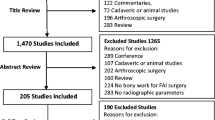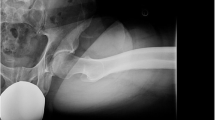Abstract
Background
Combined with clinical examination and MRI, radiographs have been mainstays in the management femoroacetabular impingement (FAI). Because hip morphology often portends intraoperative damage, radiographic features should inform surgical management.
Questions/Purposes
We determined (1) the radiographic features of the various hip morphologies; (2) the prevalence of radiographic coxa profunda in each group; (3) the radiographic differences between hips with and without coxa profunda; and (4) its sensitivity and specificity as a measure of global acetabular overcoverage.
Methods
We reviewed preoperative radiographs and operative notes of 144 hips that underwent surgical dislocation and correction for FAI between August 2002 and February 2011. Hips were divided into four FAI subtypes by radiographic analysis (cam, global overcoverage, retroversion, and combined) and three subtypes (cam, pincer, or combined) by intraarticular pathology. Standard radiographic measurements were performed, and we introduce a novel measurement that assesses femoral head coverage.
Results
We found differences in median Angle of Sharp, femoral head-neck angle, and median roof length (and its subset) among the FAI morphologies. The prevalence of radiographic coxa profunda was 48% in cam hips, 85% in global overcoverage hips, 66% in retroverted hips, and 32% in combined hips. The sensitivity and specificity of radiographic coxa profunda as a measure of global overcoverage was 75% (95% CI, 0.62–0.85) and 62% (95% CI, 0.51–0.73), respectively.
Conclusions
We found major differences in radiographic measurements between FAI morphologies. Radiographic coxa profunda was poorly specific for global overcoverage. Measurement of roof length and ratio should be used to determine the morphology of the impinging hip.
Level of Evidence
Level II, prognostic study. See Guidelines for Authors for a complete description of levels of evidence.



Similar content being viewed by others
References
Armbuster TG, Guerra JJ, Resnick D, Goergen TG, Feingold ML, Niwayama G, Danzig LA. The adult hip: an anatomic study. Part I: the bony landmarks. Radiology. 1978;128:1–10.
Beck M, Kalhor M, Leunig M, Ganz R. Hip morphology influences the pattern of damage to the acetabular cartilage: femoroacetabular impingement as a cause of early osteoarthritis of the hip. J Bone Joint Surg Br. 2005;87:1012–1018.
Benjamini Y, Hochberg Y. Controlling the false discovery rate: a practical and powerful approach to multiple testing. J R Stat Soc B. 1995;57:289–300.
Clohisy JC, Carlisle JC, Beaule PE, Kim YJ, Trousdale RT, Sierra RJ, Leuiq M, Schoenecker PL, Millis MB. A systematic approach to the plain radiographic evaluation of the young adult hip. J Bone Joint Surg Am. 2008;90(Suppl 4):47–66.
Clohisy JC, Carlisle JC, Trousdale R, Kim YJ, Beaule PE, Morgan P, Steger-May K, Schoenecker PL, Millis M. Radiographic evaluation of the hip has limited reliability. Clin Orthop Relat Res. 2009;467:666–675.
Eijer H, Leunig M, Mahomed MN, Ganz R. Crosstable lateral radiograph for screening of anterior femoral head–neck offset in patients with femoro-acetabular impingement. Hip Int. 2001;11:37–41.
Ganz R, Gill TJ, Gautier E, Ganz K, Krugel N, Berlemann U. Surgical dislocation of the adult hip a technique with full access to the femoral head and acetabulum without the risk of avascular necrosis. J Bone Joint Surg Br. 2001;83:1119–1124.
Ganz R, Parvizi J, Beck M, Leunig M, Notzli H, Siebenrock KA. Femoroacetabular impingement: a cause for osteoarthritis of the hip. Clin Orthop Relat Res. 2003;417:112–120.
Hooper JC, Jones EW. Primary protrusion of the acetabulum. J Bone Joint Surg Br. 1971;53:23–29.
Kutty S, Schneider P, Faris P, Kiefer G, Frizzell B, Park R, Powell JN. Reliability and predictability of the centre-edge angle in the assessment of pincer femoroacetabular impingement. Int Orthop. 2011 Jul 1 [Epub ahead of print].
Leunig M, Nho SJ, Turchetto L, Ganz R. Protrusio acetabuli: new insights and experience with joint preservation. Clin Orthop Relat Res. 2009;467:2241–2250.
Parvizi J, Leunig M, Ganz R. Femoroacetabular impingement. J Am Acad Orthop Surg. 2007;15:561–570.
R Development Core Team. R: A language and environment for statistical computing. Vienna, Austria: R Foundation for Statistical Computing; 2008. Available at: www.R-project.org. Accessed June 13, 2012.
Reynolds D, Lucas J, Klaue K. Retroversion of the acetabulum. A cause of hip pain. J Bone Joint Surg Br. 1999;81:281–288.
Ruelle M, Dubois JL. [The protrusive malformation and its arthroscopic complication. I. Radiological and clinical symptoms. Etiopathogenesis] [in French]. Rev Rhum Mal Osteoartic. 1962;29:476–489.
Schoenecker PL, Clohisy JC, Millis MB, Wenger DR. Surgical management of the problematic hip in adolescent and young adult patients. J Am Acad Orthop Surg. 2011;19:275–286.
Siebenrock KA, Kalbermatten DF, Ganz R. Effect of pelvic inclination on determination of acetabular retroversion: a study on cadaver pelves. Clin Orthop Relat Res. 2003;407:241–248.
Sierra RJ, Trousdale RT, Ganz R, Leunig M. Hip disease in the young, active patient: evaluation and nonarthroplasty surgical options. J Am Acad Orthop Surg. 2008;16:689–703.
Tannast M, Murphy SB, Langlotz F, Anderson SE, Siebenrock KA. Estimation of pelvic tilt on anteroposterior X-rays: a comparison of six parameters. Skeletal Radiol. 2006;35:149–155.
Acknowledgments
We acknowledge Amy Hu MS, and Dirk Larson MS, for their statistical support.
Author information
Authors and Affiliations
Corresponding author
Additional information
One of the authors (RJS) certifies that he has or may receive payments or benefits, in any one year, an amount in excess of $10,000 from Biomet Inc (Warsaw, IN, USA). One of the authors (RTT) certifies has or may receive payments or benefits, in any one year, an amount in excess of $100,000 from DePuy Orthopaedics (Warsaw, IN, USA) and less than $10,000 from Mako Surgical (Fort Lauderdale, FL, USA) and Wright Medical (Arlington, TN, USA). No other authors have any conflicts.
All ICMJE Conflict of Interest Forms for authors and Clinical Orthopaedics and Related Research editors and board members are on file with the publication and can be viewed on request.
Each author certifies that his or her institution approved the human protocol for this investigation, that all investigations were conducted in conformity with ethical principles of research, and that informed consent for participation in the study was obtained.
About this article
Cite this article
Boone, G., Pagnotto, M.R., Walker, J.A. et al. Radiographic Features Associated With Differing Impinging Hip Morphologies With Special Attention to Coxa Profunda. Clin Orthop Relat Res 470, 3368–3374 (2012). https://doi.org/10.1007/s11999-012-2539-5
Published:
Issue Date:
DOI: https://doi.org/10.1007/s11999-012-2539-5




